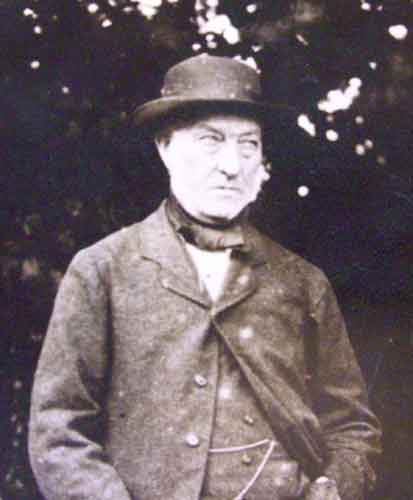1840 - 1860

Rose Monement
William Bolding
Albumen print [cropped], circa 1882
 William Bolding
(1815-1899)
William Bolding
(1815-1899) Landowner, Farmer, Miller, Brewer, Archaeologist,
Artist and member of the Norwich Photographic Society
William Johnson Jennis Bolding, the son of John and Esther Bolding, took control of the family businesses when his father died in 1847. He lived in Weybourne, a seaside village in north Norfolk, and was listed in Kelly’s Directory as ‘brewer, maltster, landowner, farmer and miller’. He was also a co-owner of an ocean-going cargo ship2, amateur archaeologist, artist, silhouettist and photographer. He joined the Norfolk Archaeology Society in 1849 and was encouraged by his friend Henry Harrod3, an antiquary (later to be secretary of the Norwich Photographic Society) to sketch his findings. Bolding’s considerable wealth enabled him to travel widely in the UK making sketches which he also did on a visit to Switzerland in 1850.
He was a talented artist, probably sometime tutored by the Norwich artist John Berney Ladbrooke4, who painted local landscapes both in oil and watercolour. Although Bolding’s favourite medium seems to have been monochrome brown and white watercolour, he contributed two works in oil, each depicting Weybourne landscapes, to the exhibitions of The Norfolk and Norwich Association for the Promotion of Fine Arts held in 1849 and 1853. The committee of this Association included William Freeman, Thomas Lound and John Middleton, all members of the Norwich School of Artists and who later became committee members of the Norwich Photographic Society.
Bolding showed four architectural photographs, printed from waxed paper negatives, at the 1856 Norwich Photographic Society exhibition: N. Runton Church Chancel; Gateway, Castle Rising; South-west Tower, Castleacre Priory and West Door, Castleacre Priory. In its published notices of the exhibition, The Norfolk News5 said of Bolding’s work ‘ … perhaps the finest proofs we have seen from waxed paper, on account of the unusual transparency of the shadows.’
The 19th century population of Weybourne was about 300, many of whom worked on the land either for Bolding or his adjoining landlord, the Earl of Orford. Bolding was a close friend of the artist John Middleton, who had been trained by Henry Bright, a distinguished member of the Norwich School of Artists. Middleton often stayed with Bolding at Weybourne and they were frequent sketching companions but whereas Middleton viewed photography as a basis for paintings, Bolding fully embraced the medium for its own sake.
He never married but lived with his sister Hannah, who acted as his housekeeper, in a residence called ‘The House’ (now the Maltings Hotel) with an adjoining barn. He converted the barn for use as a photographic studio and improved the lighting by enlarging the windows, one of which can be seen in the photograph of his studio.
In an undated letter6, probably written in the latter half of 1854, Middleton wrote to Bolding as follows:
Surrey Street
Norwich
Monday
My Dear Sir
Enclosed is a note from Owen7 about the Great Ex. series of pictures - you will see by this he will charge you 2/6 each taking the series – I think this rather high but I suppose it does not answer his purpose to do them for less – you will send me a line if you wish to have them and I will write to Owen – or I can send you his address and you can correspond with him.
The Photographic Society met on Friday night and I enroled [sic] you as a Member and paid five shillings – eighteen members have joined and there appears every chance of success – I am one of the Committee – therefore can tell you of our proceedings … Muskett8 has no more Cossey9 views – but will order some. I told him nothing but the best impressions would do …
Remember me to all at home who I hope are well …
Yours very truly, John Middleton
Bolding’s work includes magnificent photographs of his family members, employees and their neighbours. He is exceptional as an early photographer who documented working men and women and he presents his employees with dignity, seated in their working clothes, sometimes holding the tools of their trade, against plain backgrounds. Sitters included William Cook (his jobbing gardener), Billy Digby (holding a bowler hat), Charles English (holding a bill-hook and gloves), Robert Digby (a youth holding a knife), and Jon Tuck (a bespectacled, elderly man). He continued photographing throughout his life and from the mid-1850s onwards his preferred format was making albumen prints from wet collodion, glass-plate negatives.
The author wishes to acknowledge the great kindness and support given to him by Richard Jefferson who has freely shared his researches and published:
‘A Victorian Gentleman’s North Norfolk. W J J Bolding and his place in early photography’,
Hindringham:
JJG Publishing, 2013.
Sources and Notes
- Rose Monement (1860-1936) was William Bolding’s niece.
- The schooner ‘Enterprise’ was co-owned with his brother-in-law William Monement (1813-1836), a cork merchant of King’s Lynn.
- Henry Harrod (1817-1871), Fellow of the Society of Antiquaries and Joint Honorary Secretary for both the Norfolk and Norwich Archaeological Society and the Norwich Photographic Society.
- John Berney Ladbrooke (1803-1879), a member of the Norwich School of Artists.
- The Norfolk News published notices on the 6th, 13th and 20th of December 1856 and 3rd January 1857. This comment on Bolding appeared in 3rd January edition.
- Private correspondence.
- Hugh Owen (1808-1897) who exhibited a series of photographs at the Great Exhibition.
- Charles Muskett (1804-1856), bookseller of Haymarket, Norwich.
- Cossey, known today as Costessey, a western suburb of Norwich.
Richard Jefferson has also published W. J. J. Bolding (1815-1899) Pioneer North Norfolk Photographer. The Journal of the Blakeney Area Historical Society, Issue No.6, July 2003.